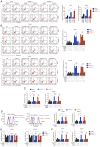Inhibition of SND1 overcomes chemoresistance in bladder cancer cells by promoting ferroptosis
- PMID: 36453257
- PMCID: PMC9773013
- DOI: 10.3892/or.2022.8453
Inhibition of SND1 overcomes chemoresistance in bladder cancer cells by promoting ferroptosis
Abstract
Chemotherapy remains one of the most important adjuvant treatments for bladder cancer (BC). However, similar to other malignancies, BC is prone to chemotherapy resistance and only approximately half of muscle‑invasive patients with BC respond to chemotherapy. The present study aimed to reveal the mechanisms underlying chemoresistance in BC cells. Cell viabilities were assessed by CCK‑8 assay. The differentiated expression of genes in chemoresistant and their parental BC cells were examined by RNA sequencing. Cell death was determined by flow cytometry. Different cell death inhibitors were used to determine the types of cell death. Levels of reactive oxygen species, iron, glutathione and malondialdehyde were assessed using the corresponding commercial kits. ChIP and dual luciferase activity assays were performed to investigate the interaction between staphylococcal nuclease and tumour domain containing 1 (SND1) and glutathione peroxidase 4 (GPX4) mRNA. RNAi was used to knockdown SND1 or GPX4. The results revealed that SND1 in BC cells were insensitive to cisplatin, and inhibition of SND1 overcame this resistance. Silencing of SND1 enhanced cell death induced by cisplatin by promoting ferroptosis in BC cells. Mechanistically, SND1 was revealed to bind to the 3'UTR region of GPX4 mRNA and stabilise it. Knockdown of GPX4 could also overcome chemoresistance, and overexpressing GPX4 reversed the effects of silencing of GPX4 on the chemosensitivity of BC cells. Thus, targeting the SND1‑GPX4 axis may be a potential strategy to overcome chemoresistance in BC cells.
Keywords: bladder cancer; chemoresistance; ferroptosis; glutathione peroxidase 4; staphylococcal nuclease and tumour domain containing 1.
Conflict of interest statement
The authors declare that they have no competing interests.
Figures





Similar articles
-
Molecular mechanisms of ferroptosis and its effects on bladder cancer.Zhong Nan Da Xue Xue Bao Yi Xue Ban. 2024 Feb 28;49(2):286-295. doi: 10.11817/j.issn.1672-7347.2024.230352. Zhong Nan Da Xue Xue Bao Yi Xue Ban. 2024. PMID: 38755725 Free PMC article. Review. Chinese, English.
-
The RNA-binding protein SND1 promotes the degradation of GPX4 by destabilizing the HSPA5 mRNA and suppressing HSPA5 expression, promoting ferroptosis in osteoarthritis chondrocytes.Inflamm Res. 2022 Apr;71(4):461-472. doi: 10.1007/s00011-022-01547-5. Epub 2022 Mar 23. Inflamm Res. 2022. PMID: 35320827
-
miR-324-3p reverses cisplatin resistance by inducing GPX4-mediated ferroptosis in lung adenocarcinoma cell line A549.Biochem Biophys Res Commun. 2021 Apr 16;549:54-60. doi: 10.1016/j.bbrc.2021.02.077. Epub 2021 Mar 1. Biochem Biophys Res Commun. 2021. PMID: 33662669
-
Abietic acid induces ferroptosis via the activation of the HO-1 pathway in bladder cancer cells.Biomed Pharmacother. 2023 Feb;158:114154. doi: 10.1016/j.biopha.2022.114154. Epub 2022 Dec 28. Biomed Pharmacother. 2023. PMID: 36584429
-
Directly targeting glutathione peroxidase 4 may be more effective than disrupting glutathione on ferroptosis-based cancer therapy.Biochim Biophys Acta Gen Subj. 2020 Apr;1864(4):129539. doi: 10.1016/j.bbagen.2020.129539. Epub 2020 Jan 18. Biochim Biophys Acta Gen Subj. 2020. PMID: 31958545 Review.
Cited by
-
Ferroptosis: An Emerging Target for Bladder Cancer Therapy.Curr Issues Mol Biol. 2023 Oct 10;45(10):8201-8214. doi: 10.3390/cimb45100517. Curr Issues Mol Biol. 2023. PMID: 37886960 Free PMC article. Review.
-
The chromatin architectural regulator SND1 mediates metastasis in triple-negative breast cancer by promoting CDH1 gene methylation.Breast Cancer Res. 2023 Oct 26;25(1):129. doi: 10.1186/s13058-023-01731-3. Breast Cancer Res. 2023. PMID: 37885030 Free PMC article.
-
Molecular mechanisms of ferroptosis and its effects on bladder cancer.Zhong Nan Da Xue Xue Bao Yi Xue Ban. 2024 Feb 28;49(2):286-295. doi: 10.11817/j.issn.1672-7347.2024.230352. Zhong Nan Da Xue Xue Bao Yi Xue Ban. 2024. PMID: 38755725 Free PMC article. Review. Chinese, English.
-
The crosstalk between SND1 and PDCD4 is associated with chemoresistance of non-small cell lung carcinoma cells.Cell Death Discov. 2025 Jan 30;11(1):34. doi: 10.1038/s41420-025-02310-5. Cell Death Discov. 2025. PMID: 39885142 Free PMC article.
-
Staphylococcal nuclease and tudor domain-containing protein 1: An emerging therapeutic target in cancer (Review).Mol Clin Oncol. 2025 Jul 17;23(4):86. doi: 10.3892/mco.2025.2881. eCollection 2025 Oct. Mol Clin Oncol. 2025. PMID: 40757241 Free PMC article. Review.
References
MeSH terms
Substances
LinkOut - more resources
Full Text Sources
Medical

